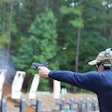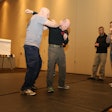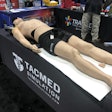Blind-side attacks against officers are often successful because many cops think nothing can be done to thwart them and therefore little effort is spent on learning to counter them. Consequently, cops are injured, disabled, and even killed by blind-side punches.
But I’m here to tell you that blind-side attacks can be thwarted and countered.
That’s right, countered. You don’t want to just survive a blind-side attack; you want to gain the advantage against the suspect who initiated the attack.
So let’s look at how you can prevent blind-side attacks, how you can survive them, and how you can take the fight to the bad guy after he attacks you.
Detecting an Attack
Preventing or deterring an attack is your primary objective. And since you can’t see the attacker when he comes up on your blind side, your best bet for preventing the attack is to hear it coming.
Listen for sudden footsteps or swishing clothing that may indicate an imminent blind-side attack. Take evasive action if you hear them.
You can also use your sixth sense to determine an imminent threat. A lot of cops, probably yourself included, have very acute street sense. If something feels hinky, it may mean that someone is coming up behind you. Check your six.
Of course, you won’t always have that sixth sense and you will not always hear the tell-tale sounds of a blind-side attack, especially in industrial areas or areas with heavy traffic.
Reflexive Action
So there are times when you will be taken by surprise. When this happens, you will need to know how to eliminate or minimize the penetration of the blind-side attack.
To help you develop your blind-side attack defense, let’s focus on transforming your natural reflex action into a defensive technique.
Reflexes are something all humans have. When you touch a hot frying pan, your reflex action is to quickly pull away. When you get surprised from behind, your natural response is to be startled and to make a sudden flinching move. Your eyes blink, your shoulders rise, and your hands come up near the chest. This is a good natural defense position, and you can assume it very fast because when startled, you automatically move at maximum quickness.
Using the Startle Reflex
The following is a five-step power move drill that will help you learn to use the startle reflex to your advantage. Start each step from a relaxed position. Your goal is to blend these five steps together so they appear to be one move when you perform them.
• Step One—Blink your eyes
The first thing that happens when you are startled is that your eyes blink. Forcing this in practice situations will condition your body and better prepare you to react and defend yourself. Intentionally blink your eyes, imagining that someone is suddenly attacking. Do this enough and whenever someone makes you blink, you will take a defensive action, instead of flinching first before you defend.
• Step Two—Transform your startle
From a standing position with your hands resting, palms toward your thighs, blink your eyes and explosively close your hands as you quickly bring them up to your chest, bending your knees slightly, and hold your position.
Next, quickly move your hands back down to their starting point on your thighs as you stand up straight (no longer bending your knees). Perform this two-part motion at least 10 times so that it starts to be comfortable.
Then perform it as one move, bringing your hands quickly up to your chest and just as quickly back down. Be sure to blink your eyes just before you start to move. Also bend your knees slightly as your hands come up to your chest.
Then stand up straight (knees no longer bent) as you bring your hands back down.
• Step Three—Catapult your hand
Explosively bring one hand in toward the center of your chest. The elbow of your arm that’s coming inward should explosively go in toward the side of your stomach.
You do this to drive your other hand out into an open-palm strike. You could use any strike with this drill. But the open-palm strike is very effective and easy to do, so I recommend it.
Be sure to look at the person who surprised you to target your strike at him and to assess if he really is a threat.
Although the catapulting hand will move first, the goal of your striking hand is to move out to perform a strike by the time your catapulting hand reaches the center of your chest. This forces your striking hand to move toward the threat with great speed.
Perform this move at least 10 times with your right hand and 10 times with your left hand. Be sure to practice both sides because you can’t choose which side a suspect will attack from.
Now, do the catapult again, blinking first and having your hands quickly close, grabbing your legs as they launch into this catapulting move.
• Step Four–Crunch your stomach
Repeat step three, catapulting one hand into your chest to drive your other hand into an open-palm strike. Except this time, explosively crunch your stomach, bringing your upper body weight quickly into the direction of the suspect. This will help you apply more of your body weight into the suspect, giving you greater force.
• Step Five—Stomp your foot
Perform steps one to four all as one move, blinking your eyes, hands grabbing your legs, one hand catapulting the other, and stomach crunching.
Do all these steps in chronological order as one move, performing at least 10 repetitions.
Next, stomp your foot on the same side of your body as your hand that is making the open-palm strike. (i.e. if you are striking with your right hand, stomp with your right foot as you step toward the suspect). This will transfer even more of your body weight into your strike.
Now perform 10 repetitions of your power move, with all the steps blended together as one move along with your stomp.
The goal for your power move is to develop enough quickness to be able to perform it completely in less time than it takes you to blink your eyes. Don’t expect this to happen overnight. It could take a couple of weeks, even a couple of months to develop.
Once you are able to do this, you are well on your way to developing the maximum quickness and power necessary to defend yourself against a blind-side attack. The power move is the platform that you’ll use to accomplish this.
Defensive Techniques
The following defensive techniques are built upon the power move that I just taught you, and they can be applied the same way for blind-side attacks from the side or rear, whether you are standing or walking.
Have someone simulate a punch to the side of your head, with a padded glove on his or her hand or place the glove on the end of a stick. You don’t need to feel a lot of impact, so there’s no need for your partner to punch you hard. If you are practicing alone, use the glove on a stick and mount it to a post, wall, or tree. Then walk into the glove to simulate a punch.
As you feel the impact to your head, apply the quickness of the power move into the following technique.
Blink as you crunch your stomach to explode your upper body away from the punch. As you do this, quickly move your hand that is closest to the suspect up toward your head as though you’re going to slap your head if it doesn’t get out of the way.
While your upper body moves away from the impact, deliver a very low shin kick into the suspect. Your kick should be a stomping motion into the suspect’s shin. Look before you kick to determine if a threat exists. Just because someone has startled you, doesn’t mean that he or she is attacking, and you don’t want to kick a fellow officer or a citizen asking you a question.
If your kick misses the suspect’s shin that’s OK. The main goal is to eliminate or reduce the impact force on your head, and the kick will help you to lean away from the impact.
The next step is to lean back toward the suspect, stomping down with your kicking leg at the same spot where it was, and then bring your hands together to apply a horizontal/vertical (HV) armbar to impact the suspect’s chest and drive him back away from you.
This armbar is formed by placing your arm that is closest to the suspect in a vertical position at the same time your other arm is in a horizontal position, grabbing your other fist. Both of your arms should be at chest level out in front of you.
Executing the HV armbar will create space between the suspect and yourself, allowing you the opportunity to employ the appropriate weapon, per your department’s use-of-force policy.
You’ll use the power move twice for this technique: once to lean away as you kick, and once again as you apply the HV armbar with tremendous force.
Here’s another strong defensive technique that you can practice.
Have someone use a glove or stick to apply a light impact to the back of your head. As soon as you start to feel the impact, blink your eyes as you perform an explosive stomach crunch to violently bring your upper body forward. Throw your hands up in the air at the same time. You will also kick behind you at shin level, stomping with the bottom of your foot. Your kick should go out and back very quickly.
As you place your foot back down, pivot on your heels to quickly turn around to apply the HV armbar into the attacker’s chest to knock him back away or down.
Now you have created the space you’ll need to apply the appropriate weapon to control the attacker, as per your department’s use-of-force policy.
Al Abidin has more than 25 years of self-defense experience. His book “How to Survive a Mugging” and DVD “Extreme Combat,” are available from Cutting Edge Combat, www.hikuta.com.















